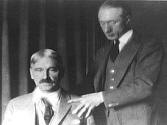Frequently
Ask Questions
What is an integrated practice?
Body Sense
utilizes the Alexander Technique in the context of physical therapy assessment and treatment. Its holistic view considers the influence of general habits of thought, movement, breathing patterns, and muscular tension on general coordination, mobility, pain patterns, and specific orthopedic and neurologic conditions.
What is the Alexander Technique?
The Alexander Technique is the practical method developed by F.M. Alexander to promote body awareness, flexibility, energy conservation, and ease in daily activity. The Technique engages the thinking process and refines our ability to perceive the way we move. Through observation, experimentation, and the Alexander teacher's guidance, you learn to consciously inhibit habitual muscular tension and minimize or eliminate awkward or inefficient movement patterns. (about the Alexander Technique)
Is the Alexander Technique
typically offered in physical therapy?
To teach the Alexander Technique requires an additional 3-year teaching certification. Unless the therapist has chosen this additional training, it would not be offered.
What is the difference
between physical therapy and the Alexander Technique?
Physical therapists and Alexander teachers both work with people who have postural and movement dysfunction. Typically, physical therapists treat their patients within a medical model, therapist to patient. I have found the educational model of the Alexander Technique (teacher and student) works well in physical therapy. The importance of patient education was emphasized at Columbia University where I received my training in physical therapy. The essential component of any treatment plan is what people take home in knowledge about their bodies, proper form in exercise programs, and self-management skills. These issues are an integral part of the teaching of the Alexander Technique.
The "Body Sense program" includes a thorough physical therapy assessment, but differs from the typical physical therapy protocol by choosing to begin with postural reeducation and functional activities based on the educational process of the Alexander Technique. The "student" takes the responsibility to investigate the role of habitual posture and muscle patterns under the guidance of the "teacher." Modalities such as massage, ultrasound, electrical stimulation, moist heat or cold pack are utilized only after the postural component has been addressed or when pain makes the educational process prohibitive. I incorporate the Alexander Technique when teaching back care, body mechanics, therapeutic exercise, or any other physical therapy modality.
My work has been well received in various hospital clinics in which I have worked. In fact, chronic back and neck pain patients are often assigned to me because of the success of the Alexander Technique.
Who benefits from the
Alexander Technique?
The Alexander Technique is offered in both physical therapy and wellness programs for:
1.) Anyone whose posture, or use of the body in movement, is poor or uncomfortable.
2.) Anyone whose occupations comprise inefficient or repetitive motions, for example, dentists, dental hygienists, carpenters, computer operators, musicians, mothers.
3.) Those who require maximum ease and efficiency in the skills they perform such as actors, dancers, musicians, riders, athletes.
4.) Anyone with physical problems that wishes to improve function in everyday activities and work efforts, assuming that poor postural coordination is a component limiting movement range, and/or contributing to pain or fatigue.
5.) Anyone interested in mind-body development such as students of Yoga, meditation, dance or those interested in improving body awareness.
The Alexander Technique benefits conditions as varied as headaches, TMJ, asthma, neck, shoulder, back and hip pain, dystonia, arthritis, osteoporosis, balance disorders, Parkinson's Disease, multiple sclerosis, and lymphedema
Medical Rehabilitation
The Alexander Technique empowers and enables people of any age to make positive, lasting changes in their personal movement patterns in daily functional activities such as walking, stair climbing, moving in and out of chairs, bending, and reaching. The Alexander Technique also addresses the more complex movement tasks of work or trade.
Who is F.M. Alexander?
Frederick Matthias Alexander was born in Australia in 1869. While pursuing a theatrical career as a young adult, he encountered difficulty with vocal projection and breathing coordination that interfered with his ability to perform. Through rigorous self-examination, he identified the cause of his problems and was able to return to the stage. His solution offered guidelines for a technique that he developed in the last decade of the 19th century and taught in England and in the United States until his death in 1955 at the age of 86. Among his students were George Bernard Shaw, John Dewey and Aldous Huxley. He trained his first class of teachers in the mid 1930's. Today his work is carried on by teachers trained in certification programs in the United States and around the world.
What does a lesson consist
of?
The teacher of the Alexander Technique analyzes the student's movement patterns in daily life: walking, sitting, bending, reaching, lifting. As the teacher guides with a gentle touch and verbal instruction, the student learns to replace faulty habits with improved coordination by locating and releasing undue muscular tensions. This preferred way of working can be applied to specialized tasks such as playing an instrument or sitting at the computer.
Why do performing artists
study the Alexander Technique?
The Alexander Technique has been embraced by music, dance, drama and opera conservatories around the world, Julliard School, Metropolitan Opera, Brevard Music Center, Aspen Music, to name a few. Students of the performing arts execute demanding physical tasks in their work, and the body wisdom of the Alexander Technique prevents repetitive stress injury and enhances expression and performance. My practice includes a wellness program for general improvement in body coordination, breathing, and voice work. Please read about all the applications on the website from horse back riding to playing the cello.
sports,
performing arts.
What can I expect?
Individual attention! All sessions are at least
one hour in length. Idelle will assess your movement pattern and its
relationship to your particular problems and complaints, develop a
protocol specific to your needs that include hands-on instruction in the
Alexander Technique to improve postural and movement coordination. She
also uses other physical therapy protocols to reduce pain and/or help
you meet your movement potential. When appropriate, she instructs an
exercise program that will work incrementally and steadily towards your
postural and movement goals including increasing strength, stretch,
postural, breathing coordination and well-being. All aspects of your
session are tailored to you with written recommendations and hand-outs
for all exercises, so that you progress at home between visits and after
being discharged.
Fees:
All sessions are one
on one and scheduled for an hour. The initial visit (evaluation, history
intake and treatment) - $ 110.00 for the hour.
Subsequent sessions are $ 90.00 for
the hour.
Payment in form of check or cash is expected at the time of visit. No
insurance filing is done at this office. Upon request, you will receive
a receipt with necessary codes to submit to
your insurance company on your own, should your insurance company accept
paper claims. You may
pay with a check from a Health Savings Account (HSA) or be reimbursed
through a Flexible Spending Account.
 |
John Dewey, American philosopher and
educator, said that he had been taken by
the Alexander Technique first because it
provided a demonstration of the unity of
mind and body. He thought that the
demonstration had struck him more
forcibly than it might have struck
someone who got the sensory experience
easily and quickly, because he was such
a slow learner. He had always been
physically awkward, he said, and
performed all actions too quickly and
impulsively and without thought.
“Thought” in his case was saved for
“mental” activity, which had always been
easy for him. It was a revelation to
discover that thought could be applied
with equal advantage to everyday
movements.
“The greatest benefit from lessons,”
Dewey said,
“was the ability to stop and think
before acting.” Physically, he noted
an improvement first in his vision and
then in breathing. Before he had
lessons, his ribs had been very rigid.
Now they had a marked elasticity which
doctors still commented on, though he
was close to eighty-eight.
Visit: The
John Dewey & F.Matthias Alexander
Homepage
|
|


